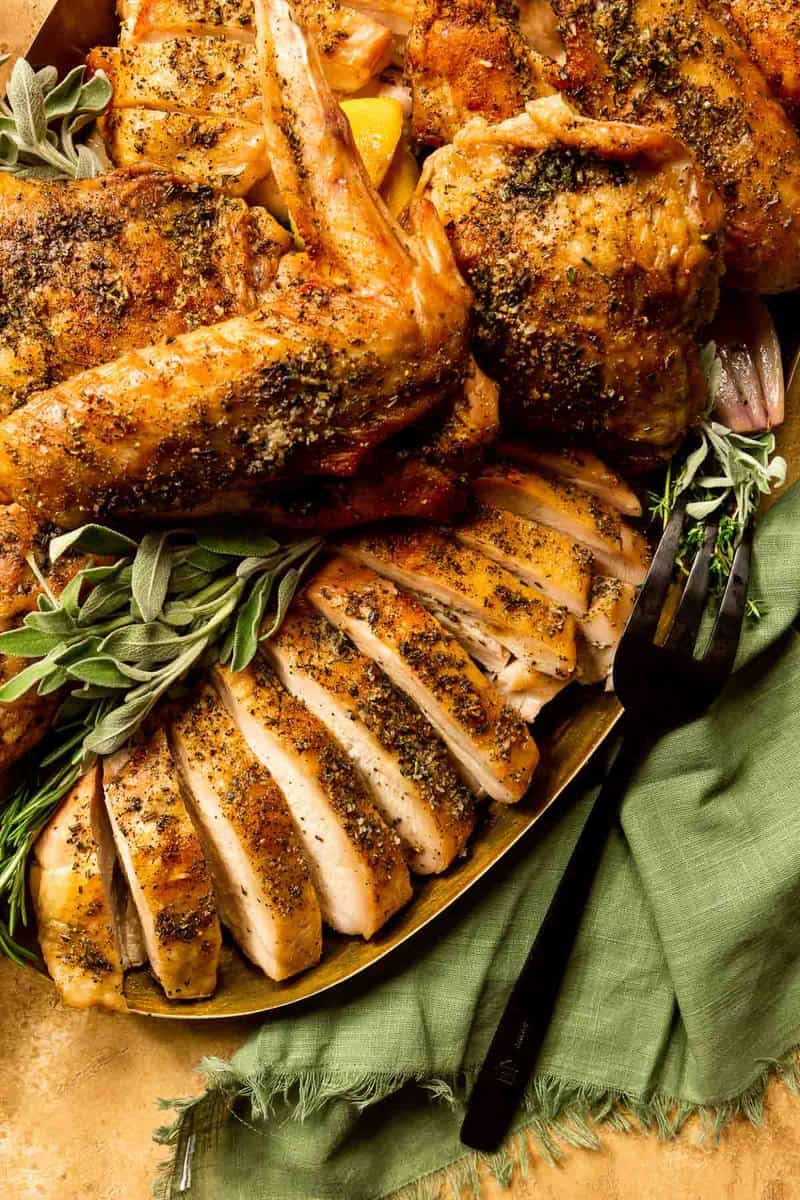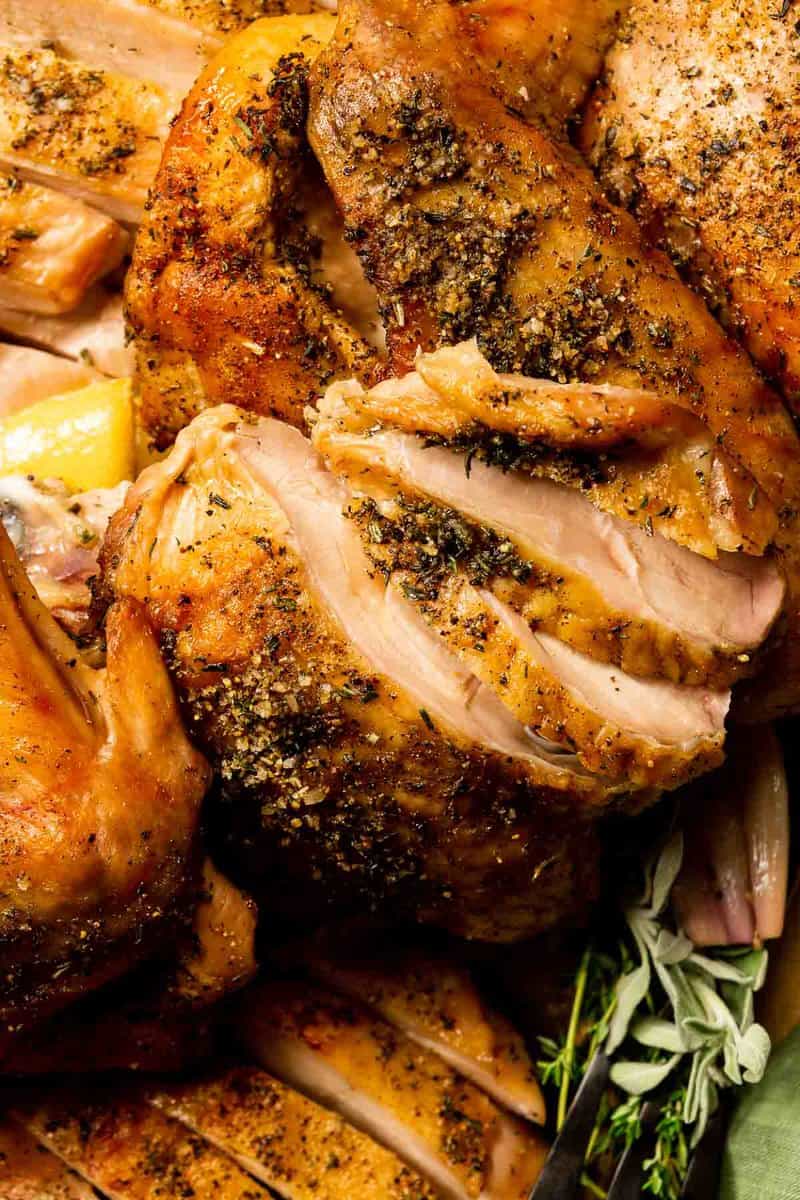Partially roasting the turkey is the key to creating an ideal cooked turkey. When a turkey is broken up and roasted in sections, it cooks evenly throughout and can be taken out of the oven as soon as it reaches the perfect temperature. No giving up perfectly cooked dark meat for perfectly cooked light meat, or vice versa. Every part is cooked perfectly!.
Roasting a turkey in parts is a fantastic way to achieve evenly cooked, juicy meat and crispy skin. This method allows you to cook the white and dark meat to their respective ideal temperatures, eliminating the risk of dryness or undercooked meat. This guide will delve into the specifics of cooking times for individual turkey parts, ensuring a perfectly cooked and delicious Thanksgiving feast.
Cooking Times for Different Turkey Parts
Turkey Breast:
- Temperature: 165°F
- Cooking Time: 1 to 2 hours
Turkey Legs:
- Temperature: 170° to 175°F
- Cooking Time: 1-1/2 to 2-1/2 hours
Turkey Wings:
- Temperature: 165°F
- Cooking Time: 1-1/2 to 2 hours
Additional Tips:
- Use a meat thermometer to accurately measure the internal temperature of the turkey parts.
- Start checking the temperature about 30 minutes before the estimated cooking time is up.
- Allow the turkey parts to rest for 10-15 minutes before carving to ensure maximum juiciness.
Resources for Roasting Turkey in Parts
Serious Eats:
- Roast Turkey in Parts Recipe: This comprehensive guide provides detailed instructions on how to break down a turkey, dry brine it, and roast it to perfection. It also includes helpful tips and variations.
Zestful Kitchen:
- Roast Turkey in Parts Recipe: This recipe offers a simplified approach to roasting turkey in parts, emphasizing ease and convenience. It includes a dry brine for added flavor and moisture retention.
Roasting a turkey in parts is an excellent way to ensure perfectly cooked meat and crispy skin. By following the recommended cooking times and using a meat thermometer, you can guarantee a delicious and stress-free Thanksgiving meal.
Frequently Asked Questions
Q: What are the benefits of roasting turkey in parts?
A: Roasting turkey in parts allows you to cook the white and dark meat to their ideal temperatures, eliminating the risk of dryness or undercooked meat. It also allows for more even cooking and crispier skin.
Q: How do I know when the turkey parts are done cooking?
A: Use a meat thermometer to check the internal temperature of the turkey parts. The breast should reach 165°F, the legs 170° to 175°F, and the wings 165°F.
Q: Can I use a different dry brine recipe?
A: Yes, you can use any dry brine recipe you like. However, the recipes provided in the resources above are specifically designed for turkey and are highly recommended.
Q: Can I roast the turkey parts at a different temperature?
A: Yes, you can adjust the roasting temperature. However, it is important to adjust the cooking times accordingly to ensure the turkey parts cook through properly.
Q: Can I use this method for other types of poultry?
A: Yes, this method can be used for other types of poultry, such as chicken or duck. However, the cooking times may need to be adjusted.
Q: What are some good side dishes to serve with roasted turkey parts?
A: Some good side dishes to serve with roasted turkey parts include mashed potatoes, stuffing, green bean casserole, and cranberry sauce.
Q: Can I make gravy from the drippings?
A: Yes, you can make gravy from the drippings. Simply follow the instructions in the resources provided above.
Q: How long will leftover turkey parts last in the refrigerator?
A: Leftover turkey parts will last in the refrigerator for 3-4 days.
Q: Can I freeze leftover turkey parts?
A: Yes, you can freeze leftover turkey parts for up to 2 months.
Q: What are some good ways to use leftover turkey parts?
A: Some good ways to use leftover turkey parts include making turkey sandwiches, turkey salad, or turkey soup.
Q: Where can I find more information about roasting turkey in parts?
A: The resources provided above offer comprehensive information on roasting turkey in parts. You can also find additional information online or in cookbooks.
Q: What are some tips for carving turkey parts?
A: Here are some tips for carving turkey parts:
- Use a sharp knife.
- Start by carving the breast meat.
- Slice the meat against the grain.
- Remove the skin from the legs and thighs before carving.
- Carve the legs and thighs into slices or chunks.
Q: What are some common mistakes people make when roasting turkey in parts?
A: Here are some common mistakes people make when roasting turkey in parts:
- Not using a meat thermometer.
- Overcooking the turkey.
- Not letting the turkey rest before carving.
- Using a dull knife.
Q: What are some variations on this recipe?
A: Here are some variations on this recipe:
- Use different herbs and spices in the dry brine.
- Add vegetables to the roasting pan.
- Baste the turkey parts with butter or olive oil during cooking.
- Glaze the turkey parts with a sauce or glaze before serving.
Q: What are some tips for making gravy from the drippings?
A: Here are some tips for making gravy from the drippings:
- Use a whisk to break up the lumps.
- Add a little flour or cornstarch to thicken the gravy.
- Season the gravy to taste with salt and pepper.
Q: What are some tips for storing and reheating leftover turkey parts?
A: Here are some tips for storing and reheating leftover turkey parts:
- Store leftover turkey parts in an airtight container in the refrigerator.
- Reheat leftover turkey parts in the oven or microwave until heated through.
Q: What are some good recipes for using leftover turkey parts?
A: Here are some good recipes for using leftover turkey parts:
- Turkey sandwiches
- Turkey salad
- Turkey soup
- Turkey pot pie
- Turkey casserole
Q: What are some tips for making turkey sandwiches?
A: Here are some tips for making turkey sandwiches:
- Use a variety of breads, such as white, wheat, or sourdough.
- Add your favorite toppings, such as lettuce, tomato, onion, and cheese.
- Spread mayonnaise or mustard on the bread.
- Toast the bread for a warm and crispy sandwich.
Q: What are some tips for making turkey salad?
A: Here are some tips for making turkey salad:
- Use leftover turkey that has been shredded or chopped.
- Add mayonnaise, celery, onion, and seasonings to taste.
- Serve the turkey salad on bread, crackers, or lettuce leaves.
Q: What are some tips for making turkey soup?
A: Here are some tips for making turkey soup:
- Use leftover turkey bones to make a flavorful broth.
- Add vegetables, such as carrots, celery, and onions.
- Season the soup to taste with salt and pepper.
Q: What are some tips for making turkey pot pie?
A: Here are some tips for making turkey pot pie:
- Use leftover turkey that has been shredded or chopped.
- Make a creamy sauce with butter, flour, and milk.
- Add vegetables, such as carrots, peas, and corn.
- Top the pot pie with a puff pastry crust.
Q: What are some tips for making turkey casserole?
A: Here are some tips for making turkey casserole:
- Use leftover turkey that has been shredded or chopped.
- Combine the turkey with pasta, vegetables, and cheese.
- Bake the casserole in the oven until heated through and bubbly.
Q: What are some tips for making gravy from the drippings?
A: Here are some tips for making gravy from the drippings:
- Use a whisk to break up the lumps.
- Add a little flour or cornstarch to thicken the gravy.
- Season the gravy to taste with salt and pepper.
Q: What are some tips for storing and reheating leftover turkey parts?
A: Here are some tips for storing and reheating leftover turkey parts:
- Store leftover turkey parts in an airtight container in the refrigerator.
- Reheat leftover turkey parts in the oven or microwave until heated through.
Q: What are some good recipes for using leftover turkey parts?
A: Here are some good recipes for using leftover turkey parts:
- Turkey sandwiches
- Turkey salad
- Turkey soup
- Turkey pot pie
- Turkey casserole
Q: What are some tips for making turkey sandwiches?
A: Here are some tips for making turkey sandwiches:
- Use a variety of breads, such as white, wheat, or sourdough.
- Add your favorite toppings, such as lettuce, tomato, onion, and cheese.
- Spread mayonnaise or mustard on the bread.
- Toast the bread for a warm and crispy sandwich.
Q: What are some tips for making turkey salad?
A: Here are some tips for making turkey salad:
- Use leftover turkey that has been shredded or chopped.
- Add mayonnaise, celery, onion, and seasonings to taste.
- Serve the turkey salad on bread, crackers, or lettuce leaves.
Q: What are some tips for making turkey soup?
A: Here are some tips for making turkey soup:
- Use leftover turkey bones to make a flavorful
Why This Recipe Works
To begin with, roasting a turkey that has been divided into separate parts allows for the proper internal temperature to be reached for each part. which means there won’t be any dried-out meat! (A huge bonus for those who enjoy white meat!) Moreover, a whole turkey can be deconstructed and prepared for consumption in approximately sixty minutes through roasting.
Not only is roasting turkey parts quick and simple, but it’s also much simpler to serve. Since the majority of the labor-intensive butchering is done before the meat cooks, you can allow the meat to rest before slicing the thighs and breasts for serving. Everything else can be served as is.
Additionally, we’re using a flavor-packed dry brine that was inspired by the dry brined whole turkey recipe by Alison Roman. The brine is loaded up with herbs and black pepper. Dry brines work incredibly well to flavor and retain moisture in meat. We discover that dry brines, as opposed to their cousin the classic brine, are far more effective at imparting flavor.
And lastly, if your refrigerator is cramped, this recipe is perfect for you. There’s no need for a big roasting pan or brining bucket—you just need to clear space for a baking sheet.

Benefits of Dry Brining
Come join the camp where less is more. This year, choose a simpler method rather than fussing over the turkey for hours or even days. Choose a dry brine instead of the untidy wet one (aka a salt, sugar and herb rub)
In addition to seasoning the turkey meat expertly and adding flavor—not just salt—a dry brine also retains moisture, keeping the meat juicy and tender.
And when a tub of turkey water isn’t sloshing around our refrigerator, we’re always happy. However, we have a thorough guide on dry brines vs. wet brines if you’re interested in using a wet brine.
For even less hassle, just drizzle a little olive oil over the skin just before roasting, rather than basting. This will promote crispiness and browning, and it will also save you from having to watch the bird for hours on end.

